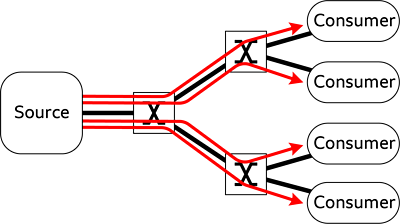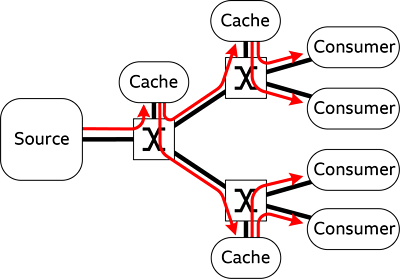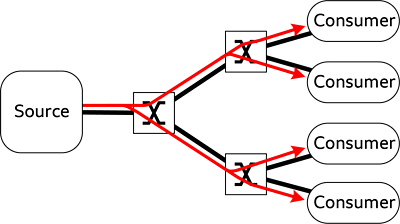Looking forward to a time when television is routinely delivered in Ultra-High Definition (UHD) or better, ±«Óãtv R&D is investigating the distribution challenges this implies.
The increasing scarcity of spare capacity on today's Digital Terrestrial Television distribution platform as valuable spectrum is reassigned to mobile network operators means that traditional broadcasting is not the obvious way to deliver higher-quality linear television or novel content experiences.
We have therefore turned our attention to IP-based distribution technologies, including over-the-top Internet, but this presents its own technical difficulties for achieving the same scalability and reliability that viewers have come to expect from broadcast services.
Project from 2012 - present
Why it matters
Today, the ±«Óãtv iPlayer uses to help it reach large audiences. These CDNs provide a tree of web caches that pull content from the ±«Óãtv's origin servers and serve it closer to end consumers. Collectively, the caches at the leaves of the tree can therefore serve popular on-demand programmes to many more viewers simultaneously than our origin servers could manage on their own.


For live streams too, CDNs can provide additional scale when lots of end users want to see the same stream at the same time. However, Ultra High Definition television presents some additional challenges because of the very high bit rates involved. It doesn't take many simultaneous UHD streams to consume all the available capacity in the CDNs. For example, we had to place an artificial limit on the total audience for our UHD coverage of the 2018 World Cup and Wimbledon Centre Court to avoid overwhelming the CDNs.
At ±«Óãtv Research & Development we have anticipated this problem and are planning for a future where all television will be delivered over packet-switched networks like the Internet. The ±«Óãtv's Chief Technology and Product Officer, has called this transition the "IP Glidepath". While CDNs will likely remain a good way of serving pre-recorded drama, entertainment and current affairs content on demand, there is still a huge appetite for streaming of live news, sport, music festivals and other big national events. In a future where all live television is distributed over IP networks, scaling up from a few thousand simultaneous viewers to millions will require a more efficient and affordable technical solution than conventional CDNs are able to provide.
- ±«Óãtv R&D - A Summer of Football and Tennis in Ultra HD
- ±«Óãtv R&D - IP Studio: Lightweight Live
- ±«Óãtv R&D - AI Opportunities: Transforming Coverage of Live Events
What We're Doing
Over the past few years we have designed and prototyped a scalable Internet broadcasting system based on IP multicast. Instead of pulling content through a tree of web caches, we instead harness the inherent capability of Internet routers to replicate packet streams. The resulting structure is still a tree, but multicast requires no additional servers, and so is inherently more efficient and scalable. This works extremely well for live streams where many users want to consume the same content at the same time, but it could also be used to pre-distribute on-demand content to edge caches in CDNs.

By combining multicast distribution to edge caches with unicast distribution downstream we are also able to support the large installed base of standards-based unicast media players. And using this hybrid model we can even support product features such as "live restart" in a scalable manner.
How it works
IP multicast is used today in managed IPTV systems around the world, but these systems are based on quite old media packaging standards that are inflexible and can't easily be consumed on modern receivers such as smartphones, tablet computers and connected television sets. We have therefore combined the IP multicast technique with more modern segmented media packaging formats such as . This allows us to use the same packaged media for multicast distribution that we are already producing for conventional CDN distribution.
We already encode the media at different qualities and bit rates to allow conventional unicast clients to dynamically adapt up and down as network conditions vary. Reusing the same packaged media segments allows us to replicate similar dynamic adaptation behaviour for multicast reception. This is particularly useful for where network conditions are more variable than in managed networks. We refer to this combination of techniques as Dynamic Adaptive Streaming over IP Multicast, or DASM for short.
Even when media streams are distributed via multicast, CDNs still have an important role to play. The Internet is an unreliable packed-switched network. Individual links can become temporarily swamped with traffic during peaks in demand, and routers routinely discard data packets in these congestion situations. Our system detects any losses in the received multicast streams and uses conventional unicast HTTP to recover the missing data in time to maintain an uninterrupted live stream for the viewer. A CDN is the obvious way of providing this loss recovery service.

HTTP recovery is straightforward in our system because we have designed the multicast transport to convey the original URL of each media segment it delivers. We have achieved this by the new to multicast use. QUIC is designed for efficient delivery of web resources and so our multicast distribution and unicast loss recovery mechanisms both speak HTTP, the common language of the web. We can receive the multicast streams on embedded equipment like home routers, but the use of HTTP also paves the way to receiving multicast streams directly in web browsers too. And because HTTP is capable of conveying any kind of web resource, we are future-proofing our streaming system for live object-based broadcasting experiences of the future too.
We're working with the , the and the to standardise the different elements of the system. was edited by ±«Óãtv R&D and published by ETSI in November 2020. We're keen to work with internet service providers to test out how well these ideas work on their networks.
Related links
Project Team
Project updates
-

Broadcast and Connected Systems section
Broadcast & Connected Systems primarily focuses on how ±«Óãtv content reaches our viewers through broadcast and Internet delivery. This involves the whole broadcast chain from playout, through coding and distribution to consumption on the end-user's device. Our work typically covers a period from now through to 3 years out from deployment.
